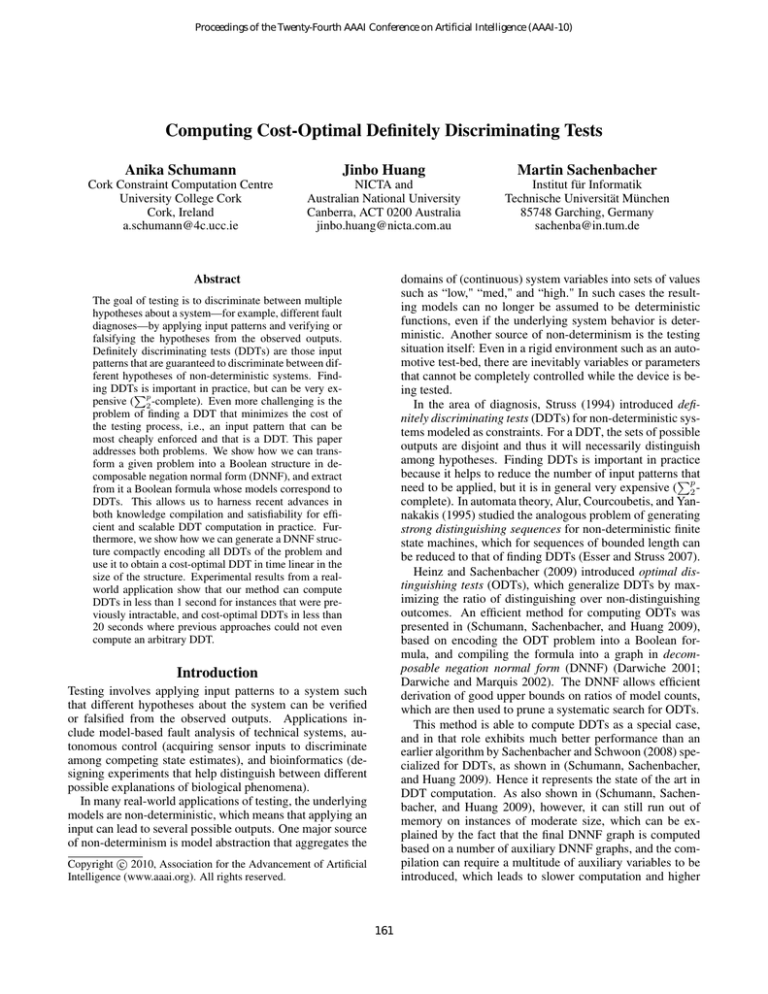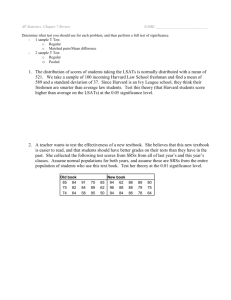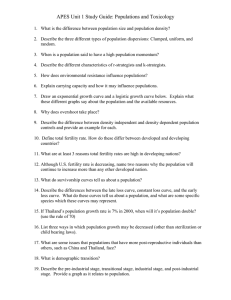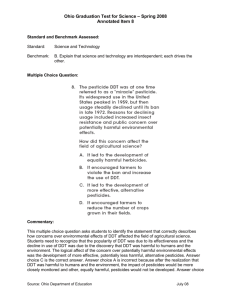
Proceedings of the Twenty-Fourth AAAI Conference on Artificial Intelligence (AAAI-10)
Computing Cost-Optimal Definitely Discriminating Tests
Anika Schumann
Jinbo Huang
Martin Sachenbacher
Cork Constraint Computation Centre
University College Cork
Cork, Ireland
a.schumann@4c.ucc.ie
NICTA and
Australian National University
Canberra, ACT 0200 Australia
jinbo.huang@nicta.com.au
Institut für Informatik
Technische Universität München
85748 Garching, Germany
sachenba@in.tum.de
Abstract
domains of (continuous) system variables into sets of values
such as “low," “med," and “high." In such cases the resulting models can no longer be assumed to be deterministic
functions, even if the underlying system behavior is deterministic. Another source of non-determinism is the testing
situation itself: Even in a rigid environment such as an automotive test-bed, there are inevitably variables or parameters
that cannot be completely controlled while the device is being tested.
In the area of diagnosis, Struss (1994) introduced definitely discriminating tests (DDTs) for non-deterministic systems modeled as constraints. For a DDT, the sets of possible
outputs are disjoint and thus it will necessarily distinguish
among hypotheses. Finding DDTs is important in practice
because it helps to reduce the number of input patternsP
that
p
need to be applied, but it is in general very expensive ( 2 complete). In automata theory, Alur, Courcoubetis, and Yannakakis (1995) studied the analogous problem of generating
strong distinguishing sequences for non-deterministic finite
state machines, which for sequences of bounded length can
be reduced to that of finding DDTs (Esser and Struss 2007).
Heinz and Sachenbacher (2009) introduced optimal distinguishing tests (ODTs), which generalize DDTs by maximizing the ratio of distinguishing over non-distinguishing
outcomes. An efficient method for computing ODTs was
presented in (Schumann, Sachenbacher, and Huang 2009),
based on encoding the ODT problem into a Boolean formula, and compiling the formula into a graph in decomposable negation normal form (DNNF) (Darwiche 2001;
Darwiche and Marquis 2002). The DNNF allows efficient
derivation of good upper bounds on ratios of model counts,
which are then used to prune a systematic search for ODTs.
This method is able to compute DDTs as a special case,
and in that role exhibits much better performance than an
earlier algorithm by Sachenbacher and Schwoon (2008) specialized for DDTs, as shown in (Schumann, Sachenbacher,
and Huang 2009). Hence it represents the state of the art in
DDT computation. As also shown in (Schumann, Sachenbacher, and Huang 2009), however, it can still run out of
memory on instances of moderate size, which can be explained by the fact that the final DNNF graph is computed
based on a number of auxiliary DNNF graphs, and the compilation can require a multitude of auxiliary variables to be
introduced, which leads to slower computation and higher
The goal of testing is to discriminate between multiple
hypotheses about a system—for example, different fault
diagnoses—by applying input patterns and verifying or
falsifying the hypotheses from the observed outputs.
Definitely discriminating tests (DDTs) are those input
patterns that are guaranteed to discriminate between different hypotheses of non-deterministic systems. Finding DDTs is important in practice, but can be very expensive ( p2 -complete). Even more challenging is the
problem of finding a DDT that minimizes the cost of
the testing process, i.e., an input pattern that can be
most cheaply enforced and that is a DDT. This paper
addresses both problems. We show how we can transform a given problem into a Boolean structure in decomposable negation normal form (DNNF), and extract
from it a Boolean formula whose models correspond to
DDTs. This allows us to harness recent advances in
both knowledge compilation and satisfiability for efficient and scalable DDT computation in practice. Furthermore, we show how we can generate a DNNF structure compactly encoding all DDTs of the problem and
use it to obtain a cost-optimal DDT in time linear in the
size of the structure. Experimental results from a realworld application show that our method can compute
DDTs in less than 1 second for instances that were previously intractable, and cost-optimal DDTs in less than
20 seconds where previous approaches could not even
compute an arbitrary DDT.
Introduction
Testing involves applying input patterns to a system such
that different hypotheses about the system can be verified
or falsified from the observed outputs. Applications include model-based fault analysis of technical systems, autonomous control (acquiring sensor inputs to discriminate
among competing state estimates), and bioinformatics (designing experiments that help distinguish between different
possible explanations of biological phenomena).
In many real-world applications of testing, the underlying
models are non-deterministic, which means that applying an
input can lead to several possible outputs. One major source
of non-determinism is model abstraction that aggregates the
c 2010, Association for the Advancement of Artificial
Copyright Intelligence (www.aaai.org). All rights reserved.
161
memory requirements.
In this paper, we present a DNNF-based method that is
adapted specifically to the problem of computing DDTs, and
requires computation of just a single DNNF graph defined
over the system variables. This representation is used to
transform a quantified Boolean formula defining the DDT
problem into a SAT problem that can be solved using an existing SAT solver. This leads to a significantly more efficient
method for computing DDTs compared to that of (Schumann, Sachenbacher, and Huang 2009).
Furthermore, we present a generalization of DNNF-based
test generation that takes into account the cost of enforcing
a given input pattern. More specifically, we show how we
can compute the values of input variables that can be most
cheaply enforced and that constitute a DDT. This is achieved
by constructing a DNNF graph, in two steps, that represents
all DDTs and allows for the retrieval of a cost-optimal DDT
in time linear in the size of the graph.
Experimental results from a real-world application show
that our method can compute DDTs for instances that were
previously intractable, and cost-optimal DDTs where previous approaches could not even compute an arbitrary DDT.
The remainder of the paper is organized as follows. We
start with an example of the testing problem, before formally defining DDTs. We then review the notion of DNNF
and a generic procedure for cost minimization with DNNF,
in the context of our testing problem. The remaining sections present our new methods for computing both DDTs
and cost-optimal DDTs, and an experimental evaluation of
them, followed by the conclusion of the paper with a few
words on future work.
throttle
a
L
L
H
H
H
p1
L
H
L
L
H
pipe
f
L
H
L
H
H
f
L
H
p2
L
H
engine
p2
L
L
H
H
H
s
L
H
L
L
H
broken-pipe
w
L
L
L
H
H
f
L
H
p2
L
L
Figure 1: Model of a gasoline engine’s air intake system
with a possibly faulty pipe component.
pipe, engine}, M2 = {throttle, broken-pipe, engine}. For
this example, we assume that enforcing a value L is always
cheaper than enforcing a value H. Hence the cheapest possible test is a = L, p1 = L, and s = L. However, this is
not a DDT because when stimulating the system with these
input values we will certainly observe low power for both of
the hypotheses and thus will not be able to distinguish them.
Indeed, there are only two DDTs in this case: (L,H,H) and
(H,H,H) (where we will observe low power only if the pipe
is broken). Hence, (L,H,H) is the cost-optimal DDT for this
example.
Example
We start with a small example that motivates and illustrates
the problems we are tackling and to which we will refer
throughout the paper.
Consider the simplified model of an automotive engine’s
air intake as shown in Figure 1. It consists of three components: engine, pipe, and throttle. There are three controllable
input variables (angle a, pressure p1 , speed s), two internal
variables (airflow f, pressure p2 ), and one observable output
variable (power w). As a simplification, we abstract from
the actual values for these variables and distinguish only the
values high (H) and low (L) for each variable. The models
of the three components are given at the bottom of Figure 1:
Definitely Discriminating Tests (DDTs)
Following the framework in (Heinz and Sachenbacher 2009;
Schumann, Sachenbacher, and Huang 2009), we assume
that the system can be modeled as a constraint satisfaction problem (CSP), which is a triple M = (V, D, C),
where D = D(v1 ) × . . . × D(vn ) are the finite domains
of finitely many variables vj ∈ V, j = 1, . . . , n, and C =
{C1 , . . . , Cm } is a finite set of constraints with Ci ⊆ D,
i = 1, . . . , m. We denote by X the set of all solutions,
that is, assignments ~x ∈ D to the variables such that all
constraints are satisfied. More formally, X = {~x | ~x ∈
D, C(~x)}, where C(~x) denotes ∀i ~x ∈ Ci .
In addition, the system under investigation defines a set
of controllable (input) variables I and a set of observable (output) variables O. Formally, a hypothesis M for
a system is then a CSP whose variables are partitioned into
V = I ∪ O ∪ L, such that I and O are the input and output variables of the system, and for all assignments to I, the
CSP is satisfiable. The remaining variables L = V \ (I ∪ O)
are called internal state variables. We denote by D(I) and
D(O) the cross product of the domains of the input and
output variables, respectively: D(I) = ×v∈I D(v) and
D(O) = ×v∈O D(v).
The goal of testing is then to find assignments of the input
variables I that will cause different assignments of output
• the higher the angle and pressure, the more airflow will be
generated by the throttle;
• the higher the airflow, the more pressure is built up in the
pipe;
• the higher this pressure and the speed the more power is
generated by the engine.
However, in case of a broken-pipe, no pressure is built up
and no air-fuel-mixture will reach the engine.
The cost-optimal testing problem for this example is to
find a test that can be most cheaply enforced and that will determine with certainty whether the pipe is broken, i.e., which
of the following two hypotheses holds: M1 = {throttle,
162
variables O for different hypotheses. In the general case
of non-deterministic systems, an input assignment can yield
more than one possible output assignments. In order to capture sets of outputs, for a given hypothesis M and an assignment ~t ∈ D(I) to the input variables, we define the
output function X : D(I) → 2D(O) with ~t 7→ {~y | ~y ∈
D(O), ∃ ~x ∈ X : ~x[I] = ~t ∧ ~x[O] = ~y }, where 2D(O) denotes the power set of D(O), and ~x[I] and ~x[O] denote the
restriction of the vector ~x to the input variables I and output variables O, respectively. Note that since M will always
yield an output, X (~t) is always non-empty.
A DDT is an assignment to the input variables such that
the sets of observable possible outputs for the different hypotheses are disjoint:
Figure 2: DNNF representing set of DDTs for the example
in Figure 1. “A" and “O" indicate AND- and OR-node, respectively. Numbers in non-leaf nodes are their identifiers.
Definition 1 (Definitely Discriminating Test) Consider
k ∈ N hypotheses M1 , . . . , Mk with input variables I and
output variables O. Let Xi be the output function of hypothesis Mi . An assignment ~t ∈ D(I)
S is a definitely discriminating test (DDT) if ∀i Xi (~t) \ j6=i Xj (~t) = Xi (~t).
be ensured with negligible overhead. The complexity of this
compilation is polynomial in the number of variables and
exponential only in the treewidth of the system in the worst
case. Figure 2 illustrates a smooth DNNF graph representing the set of DDTs for the example shown in Figure 1.1
For testing with non-deterministic automaton models instead of logical theories or CSPs, there exists the analogous
notion of strong distinguishing sequences (Alur, Courcoubetis, and Yannakakis 1995; Boroday, Petrenko, and Groz
2007). These are input sequences for a non-deterministic finite state machine, such that based on the generated outputs,
one can determine the internal state either for all feasible
runs of the machine. Finding such sequences with a length
bounded by some k ∈ N can be reduced to the problem of
finding DDTs, by unrolling the automaton into a constraint
network using k copies of the automaton’s transition and observation relation (Esser and Struss 2007). Hence in this paper we restrict ourselves to models given as (static) networks
of finite-domain constraints.
Given a smooth DNNF representation of a propositional theory it is possible to obtain a cost-optimal model in time linear in the size of the DNNF as shown in Algorithm 1.2 It
takes as inputs a smooth DNNF graph and the cost values
c(l) for each of its literals.
The cost-optimal model, i.e., the
P
subgraph for which i c(li ) is the lowest, is obtained by a
bottom-up propagation of cost values where each OR-node
is labeled by the lowest cost value of its children and each
AND-node is labeled by the sum of the cost values of its
children.
For example, let us assume the following costs for enforcing values of the input variables in the example of Figure 1:
Cost Minimization with DNNF
c(-a) = 5
c(a) = 10
Decomposable Negation Normal Form
(DNNF)
c(-p1 ) = 10
c(p1 ) = 20
c(-s)=7
c(s)=15
where c(−x) (resp. c(x)) denotes the cost for enforcing the
value L (resp. H) on variable x. A cost-optimal model for
this example can then be found by propagating these cost
values using Algorithm 1 as shown in Figure 3 (left). This
model is given by the leaves of a cost-optimal subgraph.
The latter graph is retrieved by traversing the DNNF topdown such that for each OR-node a child with the lowest
cost value is kept and for each AND-node all children are
kept. Figure 3 (right) illustrates the cost-optimal subgraph.
Hence a cost-optimal model for this example is (−a, p1 , s).
Its cost is retrieved from the cost label of the root, 40 in this
case.
Note that a cost-optimal subgraph may only give a partial
We briefly review graph-based representations of propositional theories (Darwiche and Marquis 2002). A propositional theory is in negation normal form (NNF) if it only uses
conjunction (and, ∧), disjunction (or, ∨), and negation (not,
¬), and negation only appears next to variables. An NNF is
decomposable if the conjuncts of every AND-node share no
variables. A DNNF (decomposable NNF) is smooth if the
disjuncts of every OR-node mention the same set of variables. Such a graph G represents each of its models by a
subgraph Gs that satisfies the properties:
• every OR-node in Gs has exactly one child,
• every AND-node in Gs has the same children as it has in
G, and
• Gs has the same root as G.
instantiation of the inputs, for example:
Henceforth the term subgraph always denotes a graph satisfying all of the above properties.
DNNF graphs can be generated for propositional theories
in conjunctive normal form (CNF) using the publicly available C2D compiler (Darwiche 2005), and smoothness can
1
Note that this graph is also deterministic, i.e., the disjuncts of
every OR-node are pairwise logically inconsistent. Although not
required in this work, this property is always enforced by C2D.
2
This is a variation of the minimization procedure described in
(Darwiche 2001), which labels leaves with 0 and 1 only.
163
In
where ΠI (X) is the projection of theory X on variables I.
The models of theory F are precisely the set of all DDTs.
Computing DDTs via SAT
We are now ready to tackle the two tasks described earlier:
computing DDTs, and computing cost-optimal DDTs. The
first requires one call to a DNNF compiler followed by one
call to a SAT solver.
Since projection can be performed in linear time on
DNNF (Darwiche 2001), a single call to a DNNF compiler
suffices to put ΠI (M1 ∧M2 ) (i.e., ¬F ) in DNNF. This leverages the power of DNNF compilation to obtain a compact
representation of a theory over the input variables I only.
Figure 4 (left) depicts a result of this compilation, a
DNNF graph GF̄ ,3 for the example in Figure 1. Note that
this graph does not need to be smooth, while the one described in the next section does.
What we actually need to pass on to a SAT solver is the
negation of this graph, in CNF. This can be obtained using
the well-known Tseitin translation (Tseitin 1968) coupled
with DeMorgan’s laws, where the resulting CNF will contain auxiliary variables but have a size polynomial in the
DNNF size. Tseitin’s translation consists of three steps:
Figure 3: Propagation of cost values for the DNNF graph
shown in Figure 2 on the left and a cost-optimal subgraph
on the right.
that case a cost-optimal DDT is obtained by simply enforcing the cheapest value on each remaining variable, and its
cost is obtained by adding the costs of these enforced values
to the cost label of the root of the subgraph.
Algorithm 1 Cost Minimization with Smooth DNNF
c(l)
if N is a leaf node representing
literal l
_
mini c(Ni ) if N =
Ni
c(N ) =
i
X
^
c(Ni )
if N =
Ni
i
• introduction of one auxiliary variable for each non-leaf
node of the DNNF,
• generation of clauses associated with each new variable,
• collection of all clauses into a single CNF with an additional constraint that forces the root to be true.
i
With our example graph GF̄ , we will introduce three new
variables: O1, A2, O3. Now if we impose negation at the
root, apply DeMorgan’s laws to push negations down to
leaves, and finally apply Tseitin’s translation, we obtain:
Boolean Formulation of DDTs
In order to exploit the above efficient minimization procedure for retrieving a cost-optimal DDT, we aim to compile
the DDT problem into smooth DNNF. Intuitively, this requires a propositional theory that encodes input vectors such
that it is not possible for the corresponding outputs based on
the different hypotheses to overlap. Such a theory in DNNF
can be obtained in a number of steps, described next.
Since each hypothesis Mi is a CSP, we may assume that
each Mi is given as a logical theory in conjunctive normal form (CNF) via any known translation of CSP to SAT
(Walsh 2000). Let M1 and M2 be the two hypotheses we
wish to distinguish about a system with (I, O, L) as input,
output, and internal variables. As pointed out in (Sachenbacher and Schwoon 2008), the existence of a DDT is characterized by the following quantified Boolean formula:
∃I ∀O ∀L ¬(M1 ∧ M2 ),
or equivalently,
∃I ¬(∃O ∃L (M1 ∧ M2 )),
which states that there is an input vector such that the system
cannot behave in a way consistent with both hypotheses.
Removing the quantifiers and enlisting the projection operation, we obtain the following propositional theory (denoted F ) over the input variables I only:
F = ¬(ΠI (M1 ∧ M2 )),
O3
A2
O1
O1
↔
↔
↔
↔
(a ∧ ¬a)
(p1 ∨ ¬O3)
(s ∧ ¬A2)
true
The corresponding clauses are shown in Figure 4 (right) and
serve as a CNF encoding of the DDT problem, ready to be
passed to a SAT solver.
3
We have kept the trivial OR-node (¬a ∨ a) in the graph for
illustration purposes.
{¬O3}
{¬A2, p1 , ¬O3}
{A2, ¬p1 }
{A2, O3}
{O1, ¬s, A2}
{¬O1, s}
{¬O1, ¬A2}
{O1}
Figure 4: DNNF representing the non-DDTs from which the
clauses on the right are derived, which encode the DDTs.
164
Computing Cost-Optimal DDTs
inst.
1
2
3
4
5
6
7
8
9
10
11
12
13
14
15
16
17
18
19
20
Models of the CNF encoding described in the previous section correspond to the set of DDTs, and given sufficient computational resources a SAT solver will be able to find one if
it exists.
To enable efficient cost minimization, we now invoke
once more the DNNF compiler to turn this CNF into smooth
DNNF, to which Algorithm 1 can then be applied to efficiently obtain a cost-optimal DDT (or the set of all costoptimal DDTs if desired). See Figure 3 for an example run
of this algorithm.
In a nutshell, we are able to solve the cost-optimal DDT
problem with two DNNF compilations and two linear-time
procedures (one to generate a CNF for the negation of GF̄
and one to retrieve a cost-optimal DDT).
To conclude our description of the two new DDT computation methods, Figure 5 summarizes and illustrates the
overall high-level procedures for both.
ODT
0.06
0.07
0.10
17.7
396
1566
-
coDDT
0.03
0.03
0.04
0.42
1.7
7.4
19.8
35.1
154
213
250
502
880
1292
1969
-
DDT
0.01
0.01
0.02
0.05
0.17
0.44
0.82
1.31
2.42
3.78
5.94
8.18
11.7
16.8
24.6
35.4
33.0
42.1
58.0
65.8
inst.
21
22
23
24
25
26
27
28
29
30
31
32
33
34
35
36
37
38
39
40
DDT
84.5
110
146
167
191
246
286
345
432
518
615
670
792
914
1056
1139
1329
1492
1724
1894
Table 1: Computation times in seconds for previous method
(ODT) and our new methods (cost-optimal DDT and DDT).
Figure 5: Overview of methods for DDTs and cost-optimal
DDTs.
The results indicate improvements of several orders of
magnitude over the previous state of the art. For example,
the largest instance solved by ODT (# 6) took it 1566 seconds, but took our new DDT method only 0.44 seconds,
and we were able to find a cost-optimal DDT in 7.4 seconds. The improvement allowed much larger instances to be
solved with both our new methods, and particularly with the
compilation+SAT method for DDTs.
As we briefly discussed in the introduction, the poorer
performance of the ODT method appears to be partly due
to the more complex DNNF compilations required. Figure 6
illustrates this issue in more concrete terms, where the number of nodes in the largest DNNF graph generated is shown
for each instance, for the ODT method and our new DDT
method.
For example, for instance 6 the DNNF has already over
100,000 nodes for the ODT method, but less than 3,000
nodes for the new method. Figure 6 does not show DNNF
sizes for the second compilation required by our method for
cost-optimal DDTs, but they are always smaller than in the
first compilation except in the case involving instance 1.
Finally, that our method for DDTs scales much better
than for cost-optimal DDTs is consistent with the difference in complexity between SAT and compilation. For an
illustration of this difference, consider the fact that compilations produced by the C2D compiler are known to permit model counting in linear time (Darwiche and Marquis
2002)—model counting is known to be #P-complete while
SAT is NP-complete.
Experimental Evaluation
We evaluated our new testing methods on a model of an automotive engine test-bed (Luo et al. 2007), which consists
of a throttle, a pipe, and an engine component. Compared
to the simplified example in Figure 1, this model is more
detailed as it contains additional variables and equations to
also take into account the engine’s valve control.
The model was originally given in the form of a mixed
discrete-continuous model. It has been turned into a set of
40 discrete problem instances of varying sizes by applying
domain abstractions of different granularity to the continuous variables in the model, using the method described in
(Lunze and Nixdorf 2001), and a direct encoding from CSP
to SAT (Walsh 2000).
The goal is then, for each of the instances, to find leaks in
the pipe component by assigning four controllable variables,
and observing three measurable variables.
The experiments were performed on a Linux Dual-Core
PC with 1GB of RAM using the DNNF compiler C2D (Darwiche 2005) and the SAT solver Tinisat (Huang 2007). Table 1 shows the computation times for finding a DDT using
the previous ODT method (Schumann, Sachenbacher, and
Huang 2009), a cost-optimal DDT using our new method
(two compilations), and a DDT using our new method (compilation+SAT). Blank entries signify failure due to memory
exhaustion.
165
References
Alur, R.; Courcoubetis, C.; and Yannakakis, M. 1995. Distinguishing tests for nondeterministic and probabilistic machines. In Proceedings of the ACM Symposium on Theory of
Computing, 363–372.
Boroday, S.; Petrenko, A.; and Groz, R. 2007. Can a model
checker generate tests for non-deterministic systems? Electronic Notes in Theoretical Computer Science 190:3–19.
Darwiche, A., and Marquis, P. 2002. A knowledge compilation map. Journal of Artificial Intelligence Research
17:229–264.
Darwiche, A. 2001. Decomposable negation normal form.
Journal of the ACM 48(4):608–647.
Darwiche, A. 2005. The C2D compiler user manual. Technical report, Comp. Sci. UCLA.
Esser, M., and Struss, P. 2007. Fault-model-based test generation for embedded software. In Proceedings of the 20th
International Joint Conference on Artificial Intelligence (IJCAI), 342–347.
Heinz, S., and Sachenbacher, M. 2009. Using model counting to find optimal distinguishing tests. In Proceedings of
the Sixth International Conference on Integration of AI and
OR Techniques in Constraint Programming for Combinatorial Optimization Problems (CPAIOR), 117–131.
Huang, J. 2007. A case for simple SAT solvers. In Proceedings of the 13th International Conference on Principles and
Practice of Constraint Programming (CP), 839–846.
Lunze, J., and Nixdorf, B. 2001. Representation of hybrid
systems by means of stochastic automata. Mathematical and
Computer Modeling of Dynamical Systems 4:383–422.
Luo, J.; Pattipati, K.; Qiao, L.; and Chigusa, S. 2007. An integrated diagnostic development process for automotive engine control systems. IEEE Trans. on Systems, Man, and
Cybernetics 37(6):1163–1173.
Sachenbacher, M., and Schwoon, S. 2008. Model-based
testing using quantified CSPs. In ECAI-08 Workshop on
Model-based Systems.
Schumann, A.; Sachenbacher, M.; and Huang, J. 2009.
Constraint-based optimal testing using DNNF graphs. In
Proceedings of the 15th International Conference on Principles and Practice of Constraint Programming (CP), 731–
745.
Struss, P. 1994. Testing physical systems. In Proceedings
of the 12th National Conference on Artificial Intelligence
(AAAI), 251–256.
Tseitin, G. 1968. On the complexity of derivation in propositional calculus. Studies in Constructive Mathematics and
Mathematical Logic 115–125.
Walsh, T. 2000. SAT vs. CSP. In Proceedings of the Sixth International Conference on Principles and Practice of Constraint Programming (CP), 441–456.
Figure 6: Number of nodes of the largest DNNF generated
for each of the instances in Table 1.
Conclusion and Future Work
We have presented a new algorithm for computing DDTs
that exhibits much better efficiency and scalability than
previous approaches on a realistic benchmark. This was
achieved by constructing a Boolean
formula that encodes
Pp
the complex DDT problem ( 2 -complete) and that can be
transformed into a SAT problem via DNNF compilation,
which is often very efficient for real-world problems that
have structure.
In addition we have studied the problem of computing
DDTs that can be most cheaply enforced, a problem which is
very relevant in practice but has not been considered before.
We proposed an algorithm for this problem that involves one
additional step of DNNF compilation such that cost-optimal
DDTs can be retrieved from the final DNNF in time linear
in the size of the DNNF. With this algorithm we were able
to compute cost-optimal DDTs for instances where previous
methods could not even find an arbitrary DDT.
The success of our new methods can be partly ascribed
to the fact that they are better able to exploit structural
properties of the system (compared with Sachenbacher and
Schwoon 2008), or that they require less complex DNNF
compilations (compared with Schumann, Sachenbacher, and
Huang 2009).
Topics for future work include extending our approach
to systems that admit possibly discriminating tests but not
DDTs, and to systems whose non-determinism is quantified
by a probabilistic model.
Acknowledgments
This work was supported by the Science Foundation Ireland under the ITOBO Grant No. 05/IN/I886, the Deutsche
Forschungsgemeinschaft under grant SA 1000/2-1, and
NICTA. The latter is funded by the Australian Government
as represented by the Department of Broadband, Communications and the Digital Economy and the Australian Research Council through the ICT Centre of Excellence program.
166








